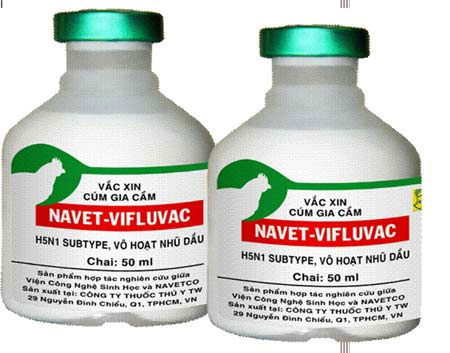March 2012: Launching H5N1 vaccine for poultry
The Central Veterinary Drug Company (NAVETCO) will bring the H5N1 avian influenza vaccine to the market right in March 2012. This proceeds to completely replace imported vaccines, helping Vietnam save hundreds of billions of dong each year.
The Scientific Council of the Department of Animal Health, Ministry of Agriculture and Rural Development (MARD) has approved the Central Veterinary Drug Company (NAVETCO) to produce the NAVET - Vifluvac vaccine. This is the research result of scientists from the Institute of Biotechnology, Ministry of Science and Technology, Ministry of Agriculture and Rural Development, National Veterinary Medicine Company from 2003 to present.
Sensitive to the need for disease prevention

Vaccines for NAVET - Vifluvac produced by NAVETCO (UK: Ho Chi Minh)
Since 2003, when the bird flu epidemic first appeared in Vietnam, the government has advocated importing Chinese bird flu vaccine. The cost for this is hundreds of billions of dong each year. But this vaccine has a drawback that is not entirely consistent with the mutated virus strain currently circulating in some northern provinces of Vietnam.
In light of this fact, the Institute of Biotechnology (Biotechnology) has contacted a number of organizations around the world to find the H5N1 strain of vaccine for the purpose of researching vaccine production. On November 3, 2005, the Biotechnology Institute received the NIBRG - 14 strain from the London Institute of Biological Standards and Quality (UK).
Immediately, the Institute made procedures to receive this virus, and also registered a research project to produce avian influenza vaccine (used in veterinary medicine).
According to the researchers, this is really an important milestone in the field of bird flu vaccine research in Vietnam. After receiving the appropriate strain, the Institute of Biotechnology scientists urgently embarked on research. This is a strain created by reverse genetics technology (the assembly of artificial influenza virus contains a full genome in which the H5 antigen gene has a "toxic" area that has been modified by genetic engineering).
From the above success, the Ministry of Science and Technology has supported the Institute of Biotechnology to continue implementing the project in phase 2, from 2007 to 2008 with the content of researching and evaluating the process of producing avian influenza vaccine. H5N1.
Moving to replace imported vaccines
A chicken farm in Xuan Mai (Hanoi) was chosen as the location to conduct the test step above. 1,500 chickens were divided into two lots, one batch of 1,000 vaccinated and one batch of 500 animals not vaccinated. After injection, periodic and non-injectable chicken blood is tested for the effect of the vaccine, resulting in 70 - 80% of vaccinated chickens producing the antibodies that meet the immunological criteria according to international standards.

Experimental injection of NAVET - Vifluvac vaccine on chickens (Photo: Ho Chi Minh)
Due to the actual demand, NAVETCO proposed in 2009 and was approved by the Ministry of Science and Technology and the Ministry of Agriculture and Rural Development and supported with the project 'Production trial of A / H5N1 flu vaccine. Oil for disease prevention for poultry 'with a budget of 1.5 billion VND to implement the above-mentioned pilot production project.
Dr. Tran Xuan Hanh, project manager - Deputy General Director of NAVETCO Central Veterinary Medicine Company, said on the basis of research results of the Institute of Biotechnology, with the help of the Ministry of Science and Technology, and Ministry of Agriculture and Rural Development. NNT, NAVETCO has carried out the project: 'Experimental production of A / H5N1 emulsion flu vaccine for prevention of disease for poultry' . Since then, the vaccine has been launched called NAVET - Vifluvac.
Currently, the project has successfully produced the same type of avian flu vaccine, NIBRG - 14, which is sterile and genetically stable. The project has also developed an industrial-scale production process for avian influenza vaccines with a capacity of 500,000 liters / batch (1,000,000 doses / batch). The vaccine has a preservation length of 12 months from the date of manufacture and is stored at 2-8 0 C.
Thus, in the coming time, Vietnam will be able to take the initiative of H5N1 avian influenza vaccine to provide domestic demand and proceed to completely replace imports.
- Vietnam produces H5N1 vaccine for poultry
- No vaccine against H5N1 has been detected in Vietnam
- Hungary prepared the vaccine against H5N1 virus
- Preparing H5N1 vaccine for poultry from ... yeast bread
- H5N1 avian influenza virus
- Nha Trang vaccine institute produces H5N1 vaccine
- Genetically modified poultry does not transmit the H5N1 virus
- Glaxo has a vaccine against H5N1
- Five countries banned entry of British poultry
- H5N1 flu appears in poultry in Ninh Thuan
- Testing H5N1 vaccine in Australia
- Injecting two trials of H5N1 vaccine made in Vietnam
 Experts comment on the mysterious gradual disappearance of the Delta variant in Japan
Experts comment on the mysterious gradual disappearance of the Delta variant in Japan Danger of the two Delta . branch variants
Danger of the two Delta . branch variants 2020 pandemic flu attack humans?
2020 pandemic flu attack humans? H7N9 can spread among family members
H7N9 can spread among family members